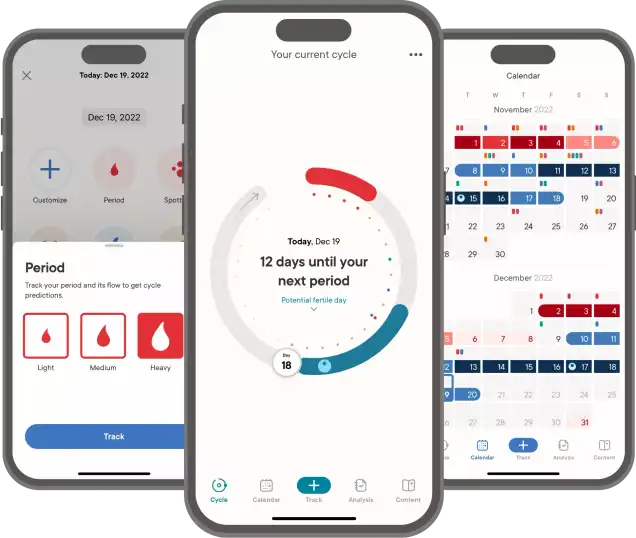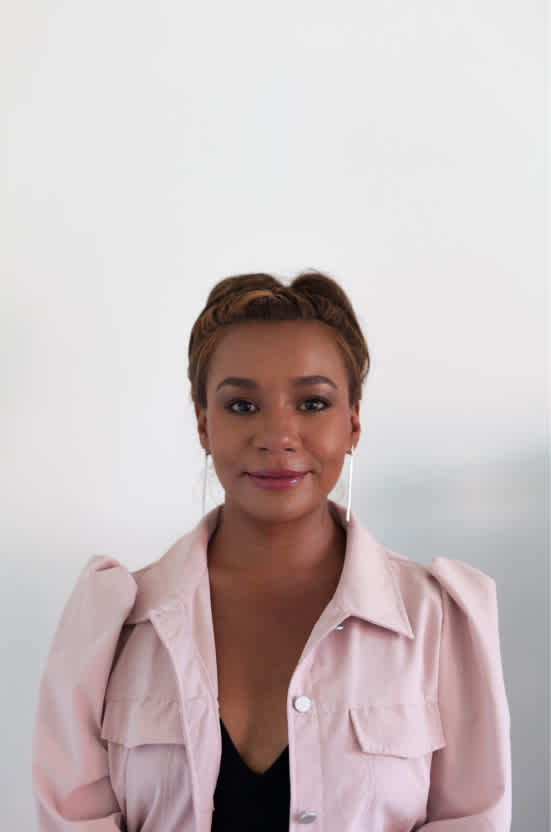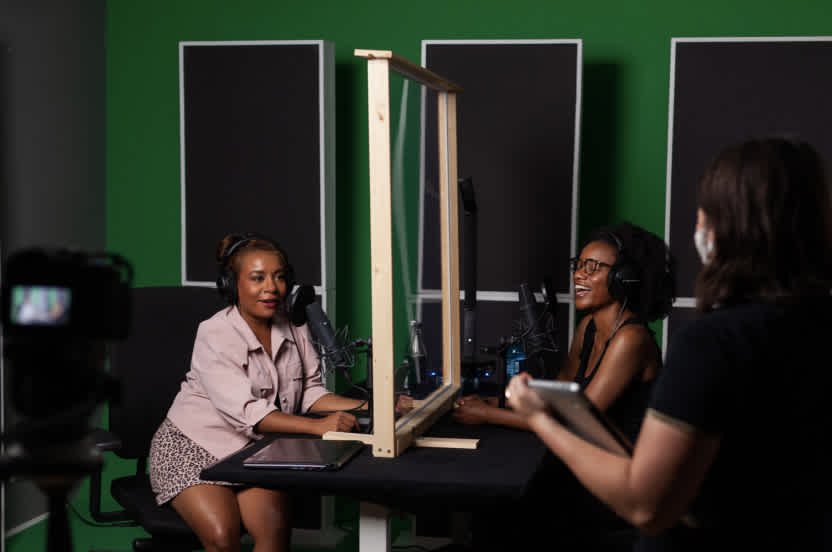


A podcast about how hormones shape our world.
Latest episode:
Who you gonna call? Mythbusters!
About Hormonal
Hormones affect everyone and everything: from skin to stress to sports.
But for most of us, they're still a mystery.
Even the way we talk about hormones makes no sense. ("She's hormonal.")
So let's clear some things up. Each week, Rhea Ramjohn is asking scientists, doctors, and experts to break it all down for us.
Subscribe on your favorite platform:
Episodes
- Season 1
- Season 2

Episode 0
August 25, 2020
A Sneak Peek at Season 2
As we work hard on Season 2 of the Hormonal podcast, we’re dropping into your feed with a special request, and a small behind the...
5 min

Episode 1
October 11, 2020
Hot or not? Birth control & sex drive
How birth control affects your sexual desire, self image, and weight fluctuations.
25 min
Support Hormonal & the period tracker that’s different from the rest.
Subscribe to Clue Plus
Episode 2
October 19, 2020
The ABC: Abortion & Birth Control
What’s it like to get an abortion and the surprising ways the pandemic is changing abortion access.
34 min

Episode 3
October 26, 2020
The many sides of side effects
Hormonal birth control: positive, negative, and neutral effects
33 min
Support Hormonal & the period tracker that’s different from the rest.
Subscribe to Clue Plus
Reproductive choice and reproductive justice
with Dr. Loretta Ross
Episode 4
November 2, 2020
Reproductive choice and reproductive justice
Accessing birth control against the odds
35 min

Episode 5
November 9, 2020
Happy birthday, birth control
Controversy and celebration on the 60th anniversary of the pill
42 min


Episode 7
November 23, 2020
Risky business: birth control during COVID-19
COVID-19 is changing how we access birth control
30 min
Support Hormonal & the period tracker that’s different from the rest.
Subscribe to Clue Plus
Who you gonna call? Mythbusters!
with Lynae Brayboy, Amanda Shea & Hajnalka Hejja
Episode 8
November 30, 2020
Who you gonna call? Mythbusters!
Clue’s Science Team busts your birth control myths
37 min
Credits
Season 2
Executive Producer: Kassandra Sundt
Host: Rhea Ramjohn
Editorial Help from: Amanda Shea, Steph Liao, Nicole Leeds
Clue Design: Marta Pucci & B.J. Scheckenbach
Web Team: Yomi Eluwande, Jane Parr-Burman, Maddie Sheesley
Special Thanks: Trudie Carter, Ryan Duncan, Aubrey Bryan,
Claudia Taylor, Léna Calvarin, Lynae Brayboy
Mixing and recording help from: Bose Park Productions & Rekorder Studios in Berlin.
About Clue
Clue is a period tracking app that uses data and science to help women and people wih cycles to understand their bodies. It's also a menstrual and reproductive health encyclopedia.
Learn more about the Clue app and check out what Clue is doing to advance menstrual health research.



Rhea Ramjohn,
host of the Hormonal Podcast


Rhea Ramjohn,
host of the Hormonal Podcast
Your Host
The more knowledge we have about our hormones, our medical & menstrual care, and our reproductive rights, the more we empower ourselves and one another.
Hormonal has offered me the true privilege of speaking with people who have the expertise on the scientific knowledge about our hormones and cycles, as well as those sharing their lived experiences, caring for people with menstruation and how, all combined, shapes our lives everyday.
Gathering facts as well as personal stories are so vital to our understanding of our health, our his/herstories, and our cultures. I deem it a privilege because we haven't had many platforms nor opportunities for menstrual health information being broadly accessible.
Episode 3
What makes a woman in women’s sports?
What makes a woman in women’s sports?
When women first began competing in elite sports, an important question cropped up: who exactly is a woman?
About
When women first began competing in elite sports, an important question cropped up: who exactly is a woman? Fears that men would simply plop on a wig and a petticoat in order to compete, to the perceived disadvantage of women, arose, and sporting officials began checking the gender of competitor.
For today’s discussion on sports and hormones, we’re joined by Katrina Karkazis. She’s the co-author of “Testosterone: An Unauthorized Biography.”
Transcript
This transcript and interview were edited for clarity.
Rhea Ramjohn: Hi, it’s Rhea Ramjohn and you’re listening to Hormonal, brought to you by Clue. Clue is the period tracking app and menstrual encyclopedia -- where we get answers to questions like, “What exactly is squirting? Is it real?”
Since elite sports first began allowing women to compete, there’s been a big question at hand: what exactly makes a woman? First, it was genitals. Then, chromosomes. And now, we’re looking at athletes’ hormones. Specifically, this so called holy grail of athletic ability: Testosterone.
But is Testosterone really a miracle compound? Or is there more cultural mythos and sexism tied up in here than we're willing to admit? And what does Testosterone have to do with women in elite sports?
For more, we’re joined now by Katrina Karkazis. She’s the co-author of “Testosterone: An Unauthorized Biography.” She’s also the senior Visiting Fellow at the Global Health Justice Partnership at Yale University. And, she’s the Carol Zicklin chair at Brooklyn College.
Katrina, welcome.
Katrina Karkazis: Thank you so much for having me.
Rhea: We’ll come back to hormones in a minute. But first, tell us exactly what are the origins of segregating sports in the first place?
Katrina Karkazis Well, if we think back a little bit over 100 years, women didn't even compete in elite sport. And in fact the powers that be actively sought to keep women out, and there were many reasons for that. One is that it was thought to be a masculine endeavor and women shouldn't be pursuing that. And as part of that ideology there was the idea that participating in sports, sorry I’m laughing, but it's a funny idea now, that would harm women. You know, that it would injure them in some way.
And inherent to this idea of women's vulnerability is the idea that they should be protected from competing with men, if you will. And in a way there is a really lovely idea around this, which is that women should be allowed to compete and they should be able to win and have all of the accolades, perhaps prizes, and other things that go with that. But it's never been completely unhinged from this idea that they're weaker. And so, then the question became: How is it that you determine who is in the women's category? And who should be eligible to compete in the women's category?
Rhea: Yeah. This is a really... It truly reveals the structured or inherent sexism and genderism of elite sports. You know, and we have to also have to keep in mind what this means for all the genders: binary, non binary, or gender nonconforming. So I really appreciate delving into this conversation with you today.
So tell us a little bit about how sports governing bodies began determining what they defined as gender? What’s the history here?
Katrina: Yeah. That's a really great question, because you might ask yourself: how do you actually know who's a woman? Where, how do you figure this out? Do you think about someone's social identity? Their legal identity? Do you think about their body? If so, what body parts do you think about? What, you know, sort of, what gets singled out as being important?
So as early as the 1930s, 1940s there were these ridiculous things called “certificates of femininity,” and you had to be issued one in order to compete. And it's not clear, actually, what different countries did regarding the issuance of that so it is possible that they relied on some kind of physical check.
But when we know that [physical checks] really entered into sort of sporting regulation, sporting practice, was in the 1960s. And in 1966, 1967, the two main sports governing bodies that have done these kind of gender verification or sex testing practices have been the Olympic Committee and the governing body for track and field [IAAF]. And they did a couple of different things, [at[ different times. But, the earliest checks were gynecological exams of women and also what have been called "nude parades," where women would walk in front of a panel, I believe they were always all men, who would observe their physical body and make a determination about whether or not they should be allowed to compete in the female category.
As you might imagine, this didn't last very long.
Rhea: Yeah, that's really crazy to imagine having to be subjected to that.
Katrina: Well, I mean, the interesting thing is that, and I know we’ll come back to this, but we're actually not done with physical inspections. People sort of like to at times draw a bright line between what was happening in the 1960s, and the way that these practices have carried forward. But no matter what period we talk about, women who are investigated regarding eligibility regulations almost always undergo a physical exam and a genital exam.
So what's different now versus then, is whether it's mandatory for all women. But it's absolutely the case that those practices are not done and that they continue until this very moment.
Rhea: So break that down for us a little bit. I mean you talked about these “femininity certificates” which I'm glad we've done away with that now. But what does this “verification process” look like now in elite competition, sporting competition?
Katrina: Well this is where I think it ties really well into the title of your podcast, because it relies on hormones, and it relies on testosterone specifically.
Skipping over this long period from sort of “certificates of femininity” to the current moment, let's just say that what sports governing bodies did was try to single out one physiological sex characteristic. And so people might say, “Well, what are those?” Well, we know most of them, chromosomes, genitalia, gonads and even hormonal levels. And so these sports governing bodies would say, “OK, we'll look at your hormones or we'll look at your chromosomes,” and based on that, for example whether you have XX, XY, or some other combination you'll be eligible or not.
So those became problematic not because we don't know how to test for those things. The tests are accurate. They became problematic because depending upon what physiological characteristics you count, there are six to nine, and none are decisive regarding sex determination.
In other words: You can't say that all individuals with ovaries are women. Or that all individuals with testes are men. There are actually women who have testes. So, this is true for every single sex trait you can think about.
And finally, sports governing bodies stopped mandatory sex testing for all individuals but they always did a reserve clause and then eventually they shifted to testosterone.
So your question was… that was a really long preamble to sort of get to where we're at now.
Rhea: It’s all good.
Katrina: But your question is sort of: How does this work? And there are regulations in place right now for track and field, but fairly soon we're going to hear the Olympic ones for Tokyo 2020. And what they say is, "Hey, if you want to compete in the female category, you have to have testosterone levels below five nanomoles per litre. And you need to have sensitivity to those testosterone levels.”
So. If you're a woman, you have natural levels above this, [then] you have to lower your testosterone or not compete at all, or they have actually suggested, which is one of the most ludicrous sort of harmful suggestions, that you can compete with men. Which is ridiculous because this is actually a secondary layer of eligibility. The first one is often legal sex. So women can't compete with men because they're not legally men. But basically there's a threshold that says if you're above it you've got too much of this and I say this like in scare quotes, “You’ve got too much of this male hormone and we think that's a problem. And it makes you too powerful. You have an unfair advantage against your female competitors. And for that reason in order to level the playing field we're going to require that you lower your testosterone.”
[SPONSOR BREAK]
Announcer: Hormonal is brought to you by Clue. The period tracking app, and menstrual health encyclopedia, that takes YOUR cycle seriously.
Kate: So we work with a lot of scientists to be able to provide the best and the most scientific content for our users.
Meet Kate.
Kate: Hi, I'm Kate. I'm an engineering manager and I work at Engineering at Clue.
Announcer: Not only is she a Clue engineer, but she’s also a Clue user.
Kate: from time to time I get the feedback from the users that they have discovered something that they didn't know before and that is something that makes me happy because I have been that person, I have been the person that thinks, “Oh my if I have a bunch of like woman friends all my cycles are going to like synchronize!” or things that's a myth, but you don't know, in science. and clue provides that scientific approach that I really like.
Announcer: To support the app and the work at Clue, subscribe to Clue Plus.
Your subscription funds the work here at Clue, the period tracking app that doesn't sell your data, doesn't show you a bunch of ads, and was founded and is led by women.
For more -- check out Clue.Plus.
Alright, back to the show.
[End of Sponsor Break]
Rhea: Wow. This sounds like a very intrusive way of asking an athlete to participate in their passion. It sounds incredibly unfair. Does this mean that none of the sports’ governing bodies around the world have a standardized method for testing this testosterone?
Katrina: Bingo. Yeah. And so, not only is there not one uniform regulation across all sports governing bodies, but the process by which women are identified to be tested is often suspicion based.
And so what do I mean when I say that? Well, what I mean is it's very often the “lookers,” and the lookers can be sports governing body people, they can be doping control officers, they can actually be fellow competitors, who have the sense that a woman appears “too masculine.” And again we have to sort of put aside for a second, what in the world that means? Like what does it mean to be too masculine. Right?
Rhea: Right. Yeah.
Katrina: But thinking that that is a huge category and that that's going to be different for you, for me, for everybody looking then women can be targeted and they'll say, “OK this woman strikes whomever as too masculine and we're going to require her to undergo investigation.” And here's where we come back to where we started. One of the very first things that happens regarding this investigation is a physical exam and especially a genital exam and you might say... I don't know. Are you? Are you saying why? Like, what in the world? Why would we even do this?
Rhea: Lots of lots of the whys.
Katrina: Yes, Should I tell you why?
Rhea: Yes, absolutely. I want to hear.
Katrina: So this is where we come back to where we started the podcast, which is that women are undergoing physical exams, once they've been targeted for investigation, and most especially genital exams.
And so you might say, “Well why? If you want to know somebody’s testosterone level, don't you just look in the blood grab a blood sample?” And that's absolutely one way to determine it. But there's two pieces to having testosterone. One is that you have a level in your body. The other is that you have tissues or receptors that respond to it and you need both of those pieces in order for your body to be able to use the testosterone that you have.
So, this is where the genital exam comes in. Clinicians and others think that the clitoral size is a very good indicator of a person's testosterone receptivity. Basically what they do is a gynecological exam to look at the size of the clitoris and in many ways this must sound utterly ridiculous, like you know there's no such thing as clitoral weightlifting.
So, they look at the clitoral size to determine, as a proxy if you will, to try to understand how sensitive someone's tissues are. And essentially, the larger the clitoris, the more bang for the buck, they think, in terms of somebody’s athletic capacity.
So this is now where we're at in terms of these regulations, is that based on the testosterone level result, based on the assessment or desire to assess sensitivity via the clitoris, they try to make a determination about whether or not they think somebody is benefiting from a kind of unfair advantage in terms of their testosterone level.
Rhea: Katrina, that not only sounds incredibly intrusive, and a truly horrible experience for the athlete, but also bizarre. I mean, what did they mean by “too big?” How big is too big when we’re talking about a so-called advantage?
Katrina: So totally subjective. Just eyeball exam, if it struck the person observing that the clitoris was too large to be on a woman then that is what made it problematic.
And it's not just here that that's happening, there's a history of this around exams for people with intersex variations, which is always this subjective assessment of, “I think that's too big of a clitoris to be on a woman.”
And here, one of the things we didn't talk about, is that there are women who have been targeted under the regulation who lowered their testosterone, who also underwent clitoridectomy, which of course has nothing to do with sports performance but it's considered a package of interventions for women with intersex variations. And that's why it was performed and it's horrific that that happened.
Rhea: Speaking of women with intersex variations, we did have that case in 1984, in 1985 of Maria Jose Martinez Patino, who I believe was, her chromosomes were tested and she was found to be an intersex person, and then consequently stripped of all of her women's track and field medals.
This reminds me so much of the current case that we have in sports. That's the case of Caster Semenya. And I was wondering if you could tell us a little bit more or give our listeners a little bit of background on what that case is and what that and what relevance testosterone and hormone testing has in the case of Caster Semenya?
Katrina: Sure. Caster Semenya is an extraordinary athlete from South Africa and primarily an 800 meter runner. And in 2009, she raced at the Berlin World Championships. And based on the kind of suspicion based testing and targeting of women, was singled out for testing. And in short, for 10 years she has been hounded by track and field sport governing body.
And for a lot of the reasons that you mentioned a couple of minutes ago. She is a lesbian. She's black. She presents as more butch. She's incredibly powerful. She's muscular. She wears clothing that is not the skimpy clothing that a lot of her competitors wear. And I think a lot of these things, sort of her gender presentation, if you will, or her sexuality, have brought her under scrutiny.
And. It's a long complicated story about what's happened to her. But. We had a brief period of four years when there were no regulations which was extraordinary and that is because of an Indian sprinter Dutee Chand, also targeted for very similar reasons who won a case at the Court of Arbitration for Sport.
[Dutee] basically said, “These regulations discriminate against women, they discriminate against a natural physiological trait, and the scientific evidence for unfair advantage isn't there.”
And she won her case.
Then what happened is the sport governing body came back and said, “We're going to introduce new regulations that are a much narrower range of events,” and Dutee couldn't challenge that case because she doesn't compete in those events. Without her ability to challenge that case, Caster Semenya came forth to challenge these regulations. And we're really in the middle of a very important historical moment, because unfortunately the Court of Arbitration for Sport, which is the ruling body, if you will, regarding sports regulations, ruled against Caster Semenya and it sided with the sports governing body for track and field, which is the IAAF, and said, “You have sufficient evidence to show that there is an unfair advantage.”
And this is unfortunate because this science is deeply contested. But Caster then appealed this decision to the Swiss Federal Tribunal and that is the decision that we're awaiting now.
But in the meantime, they've said, and upheld the current regulations, so that any woman right now with high testosterone who has an intersex variation is not allowed to compete at the international level in the range of events that they've applied this to.
Rhea: Could you tell us a little bit more about what Semenya has actually been experiencing in these last ten years?
Katrina: You know, I would argue that she's actually been through multiple layers of incredibly violating kinds of both investigations, but also discussions about her body, so that even from 2009, it was argued, that her medical records were leaked to the press.
So not only has she undergone intense genital exams, likely questions about her sexual history, menstruation history, physical exams of her breast, internal exams, you know, can be of the vagina, ultrasound of the internal organs, MRI, multiple blood tests. There's this other layer which is I mean... it blows my mind the extent to which journalists and others are comfortable talking about the most intimate and private aspects of somebody’s body, especially when it has been known that anything that's being talked about, whether it's accurate or not, was leaked and yet they continuously repeat all manner of things about her physiology in the press over and over.
Rhea: And what happens if Caster actually loses her case?
Katrina: If Caster loses her case quite honestly, I feel it's catastrophic because it means that women with a natural physiological trait will be kept out of elite sport not able to pursue the events, you know, in which they excel, in which they identify with, in which they've trained their whole lives to compete in.
And we will have enshrined and endorse discrimination against women, discrimination against women with intersex variations. And it's a regulation that almost exclusively burdens women of color from the Global South. And so we will allow that disproportionate burden to stay in place, and I would argue, without scientific evidence to support the claims that are being made about the role of testosterone and particularly higher testosterone among elite women athletes.
So it's really a step backwards. And it just means that we will have to find other ways to challenge these regulations.
Rhea: It sounds like what you've been telling me is that across the globe there is no single biological marker that all women share. Is that right?
Katrina: That's absolutely correct.
Rhea: So and we know that the differing sports governing organizations are using different tests of different physiological markers. So, in terms of studying hormones, what can you tell us about the research, about how the presence of estrogen and testosterone affect athletic performance in general?
Katrina: Well, there's been almost no research on estrogen and the reason for that is, it has to do with sort of cultural ideologies and mythologies. Testosterone comes with a hundred year, quite sedimented, identity as a male hormone, as a male sex hormone, as the driver of all things masculine. And it's interesting to me that that identity has barely shifted over the last hundred years, despite what we know about this hormone, so even the earliest researchers studying testosterone found findings that they found to be anomalous and confusing. And that didn't unsettle their notion that it was a male sex hormone or responsible for activities behaviors and ways of thinking if you will considered stereotypically masculine.
And, so the fact that the sports’ governing bodies have drawn on testosterone as a marker, has sort of done a lot of work for them, because most people think it's problematic in women. Most people think that it is the ultimate or primary driver, the master molecule if you will, of athleticism. And they think this without needing to consult any research, right? It's just sort of an idea you can pull off the shelf.
But what we know, sort of speaking at a high level, is that it's absolutely not the people with the highest levels that always do the best. That at times people with lower levels do better.
And that the IAAF's own research supports this finding. So that even in their own work, out of three out of the eleven events that they looked at in running events in track and field, women with the lower levels did better than women with the higher levels. And you can't rank performances by testosterone level. And it's not the case that a little bit more will make you do a little bit better.
Rhea: OK. So, with all of this in mind knowing that every person's hormonal makeup is different, it's also a response to their community [and] external factors, we have of course all of the sexist terminology of how we've looked at how we study bodies and hormones over the last hundred years, with all of this in mind, is segregation of the genders in sports actually necessary or is it arbitrary? What are your thoughts on that?
Katrina: I really love that you've asked this, and while it's not an area that I spend a lot of time doing work or research on I think it's a really important question because if we didn't have sex segregation, we certainly wouldn't be having these conversations around how you sex segregate.
And not all sports are sex segregated and not all sports are sex segregated at all levels. And one of the things that's really interesting, women aren't allowed to compete in the Tour de France. That's not for, there's no physical reason why women are blocked from the Tour de France. Even when women were fighting for the Vancouver Olympics, to be able to do downhill ski jumping, the head of the International Ski Federation said that he was worried that women's uteruses would fall out upon the hard landing.
Rhea: Oh my. OK.
Katrina: There are going to be a lot of people that when you even raise this topic of, “What do you mean no sex segregation in sport?” That you know, we need to say, OK hold on. Cool your jets for a second. Like hold back on that reaction and let's think about some of the examples that we just talked about and say, "Is there a way to think about what merits segregation, and what doesn't, and why?"
And I think that's a really important question to ask. I think one of the very first questions to ask is as long as sport is sex segregated, why are things like ice skating routines different lengths for men and women there is no reason for that to be the case.
So there's a lot of ways, right, in which gender ideology is infusing these regulations, is infusing what we think is right, in ways that are harmful to women. And so one of the things that I've long thought is that protection of women is the cloak under which discrimination against women takes place. And if we want to stop that discrimination I think it's important to open for conversation the assumed necessity of sex segregation for all sports.
Rhea: I could talk to you for hours about sports. I found this so fascinating. Thank you so much, Katrina Karkazis, senior visiting fellow at the Global Health Justice Partnership at Yale University. She is the Carol Zicklin Chair at Brooklyn College and the co-author of "Testosterone: An Unauthorized Biography."
Thank you so much. Katrina for joining us on Hormonal.
Katrina: It was such a pleasure to talk to you. Thank you so much.
Rhea: Hormonal is brought to you by Clue. If you like the podcast, subscribe and rate us five stars on your platform of choice. Or find us on social media!
To support the work here at Clue -- subscribe to Clue Plus. Every cent goes towards informing you -- that includes the app and the archives of meticulous menstrual health information on the Clue website. Including the answers to the question at the top of the show. Check the links in the show notes for more.
You can find out more about Clue Plus at Clue.Plus.

Episode 3
October 14, 2019
What makes a woman in women’s sports?
When women first began competing in elite sports, an important question cropped up: who exactly is a woman?
About
When women first began competing in elite sports, an important question cropped up: who exactly is a woman? Fears that men would simply plop on a wig and a petticoat in order to compete, to the perceived disadvantage of women, arose, and sporting officials began checking the gender of competitor.
For today’s discussion on sports and hormones, we’re joined by Katrina Karkazis. She’s the co-author of “Testosterone: An Unauthorized Biography.”
"And I think that's a really important question to ask. I think one of the very first questions to ask is as long as sport is sex segregated, why are things like ice skating routines different lengths for men and women there is no reason for that to be the case. "
Rhea Ramjohn: Hi, it’s Rhea Ramjohn and you’re listening to Hormonal, brought to you by Clue. Clue is the period tracking app and menstrual encyclopedia -- where we get answers to questions like, “What exactly is squirting? Is it real?”
Since elite sports first began allowing women to compete, there’s been a big question at hand: what exactly makes a woman? First, it was genitals. Then, chromosomes. And now, we’re looking at athletes’ hormones. Specifically, this so called holy grail of athletic ability: Testosterone.
But is Testosterone really a miracle compound? Or is there more cultural mythos and sexism tied up in here than we're willing to admit? And what does Testosterone have to do with women in elite sports?
For more, we’re joined now by Katrina Karkazis. She’s the co-author of “Testosterone: An Unauthorized Biography.” She’s also the senior Visiting Fellow at the Global Health Justice Partnership at Yale University. And, she’s the Carol Zicklin chair at Brooklyn College.
Katrina, welcome.
Katrina Karkazis: Thank you so much for having me.
Rhea: We’ll come back to hormones in a minute. But first, tell us exactly what are the origins of segregating sports in the first place?
Katrina Karkazis Well, if we think back a little bit over 100 years, women didn't even compete in elite sport. And in fact the powers that be actively sought to keep women out, and there were many reasons for that. One is that it was thought to be a masculine endeavor and women shouldn't be pursuing that. And as part of that ideology there was the idea that participating in sports, sorry I’m laughing, but it's a funny idea now, that would harm women. You know, that it would injure them in some way.
And inherent to this idea of women's vulnerability is the idea that they should be protected from competing with men, if you will. And in a way there is a really lovely idea around this, which is that women should be allowed to compete and they should be able to win and have all of the accolades, perhaps prizes, and other things that go with that. But it's never been completely unhinged from this idea that they're weaker. And so, then the question became: How is it that you determine who is in the women's category? And who should be eligible to compete in the women's category?
Rhea: Yeah. This is a really... It truly reveals the structured or inherent sexism and genderism of elite sports. You know, and we have to also have to keep in mind what this means for all the genders: binary, non binary, or gender nonconforming. So I really appreciate delving into this conversation with you today.
So tell us a little bit about how sports governing bodies began determining what they defined as gender? What’s the history here?
Katrina: Yeah. That's a really great question, because you might ask yourself: how do you actually know who's a woman? Where, how do you figure this out? Do you think about someone's social identity? Their legal identity? Do you think about their body? If so, what body parts do you think about? What, you know, sort of, what gets singled out as being important?
So as early as the 1930s, 1940s there were these ridiculous things called “certificates of femininity,” and you had to be issued one in order to compete. And it's not clear, actually, what different countries did regarding the issuance of that so it is possible that they relied on some kind of physical check.
But when we know that [physical checks] really entered into sort of sporting regulation, sporting practice, was in the 1960s. And in 1966, 1967, the two main sports governing bodies that have done these kind of gender verification or sex testing practices have been the Olympic Committee and the governing body for track and field [IAAF]. And they did a couple of different things, [at[ different times. But, the earliest checks were gynecological exams of women and also what have been called "nude parades," where women would walk in front of a panel, I believe they were always all men, who would observe their physical body and make a determination about whether or not they should be allowed to compete in the female category.
As you might imagine, this didn't last very long.
Rhea: Yeah, that's really crazy to imagine having to be subjected to that.
Katrina: Well, I mean, the interesting thing is that, and I know we’ll come back to this, but we're actually not done with physical inspections. People sort of like to at times draw a bright line between what was happening in the 1960s, and the way that these practices have carried forward. But no matter what period we talk about, women who are investigated regarding eligibility regulations almost always undergo a physical exam and a genital exam.
So what's different now versus then, is whether it's mandatory for all women. But it's absolutely the case that those practices are not done and that they continue until this very moment.
Rhea: So break that down for us a little bit. I mean you talked about these “femininity certificates” which I'm glad we've done away with that now. But what does this “verification process” look like now in elite competition, sporting competition?
Katrina: Well this is where I think it ties really well into the title of your podcast, because it relies on hormones, and it relies on testosterone specifically.
Skipping over this long period from sort of “certificates of femininity” to the current moment, let's just say that what sports governing bodies did was try to single out one physiological sex characteristic. And so people might say, “Well, what are those?” Well, we know most of them, chromosomes, genitalia, gonads and even hormonal levels. And so these sports governing bodies would say, “OK, we'll look at your hormones or we'll look at your chromosomes,” and based on that, for example whether you have XX, XY, or some other combination you'll be eligible or not.
So those became problematic not because we don't know how to test for those things. The tests are accurate. They became problematic because depending upon what physiological characteristics you count, there are six to nine, and none are decisive regarding sex determination.
In other words: You can't say that all individuals with ovaries are women. Or that all individuals with testes are men. There are actually women who have testes. So, this is true for every single sex trait you can think about.
And finally, sports governing bodies stopped mandatory sex testing for all individuals but they always did a reserve clause and then eventually they shifted to testosterone.
So your question was… that was a really long preamble to sort of get to where we're at now.
Rhea: It’s all good.
Katrina: But your question is sort of: How does this work? And there are regulations in place right now for track and field, but fairly soon we're going to hear the Olympic ones for Tokyo 2020. And what they say is, "Hey, if you want to compete in the female category, you have to have testosterone levels below five nanomoles per litre. And you need to have sensitivity to those testosterone levels.”
So. If you're a woman, you have natural levels above this, [then] you have to lower your testosterone or not compete at all, or they have actually suggested, which is one of the most ludicrous sort of harmful suggestions, that you can compete with men. Which is ridiculous because this is actually a secondary layer of eligibility. The first one is often legal sex. So women can't compete with men because they're not legally men. But basically there's a threshold that says if you're above it you've got too much of this and I say this like in scare quotes, “You’ve got too much of this male hormone and we think that's a problem. And it makes you too powerful. You have an unfair advantage against your female competitors. And for that reason in order to level the playing field we're going to require that you lower your testosterone.”
[SPONSOR BREAK]
Announcer: Hormonal is brought to you by Clue. The period tracking app, and menstrual health encyclopedia, that takes YOUR cycle seriously.
Kate: So we work with a lot of scientists to be able to provide the best and the most scientific content for our users.
Meet Kate.
Kate: Hi, I'm Kate. I'm an engineering manager and I work at Engineering at Clue.
Announcer: Not only is she a Clue engineer, but she’s also a Clue user.
Kate: from time to time I get the feedback from the users that they have discovered something that they didn't know before and that is something that makes me happy because I have been that person, I have been the person that thinks, “Oh my if I have a bunch of like woman friends all my cycles are going to like synchronize!” or things that's a myth, but you don't know, in science. and clue provides that scientific approach that I really like.
Announcer: To support the app and the work at Clue, subscribe to Clue Plus.
Your subscription funds the work here at Clue, the period tracking app that doesn't sell your data, doesn't show you a bunch of ads, and was founded and is led by women.
For more -- check out Clue.Plus.
Alright, back to the show.
[End of Sponsor Break]
Rhea: Wow. This sounds like a very intrusive way of asking an athlete to participate in their passion. It sounds incredibly unfair. Does this mean that none of the sports’ governing bodies around the world have a standardized method for testing this testosterone?
Katrina: Bingo. Yeah. And so, not only is there not one uniform regulation across all sports governing bodies, but the process by which women are identified to be tested is often suspicion based.
And so what do I mean when I say that? Well, what I mean is it's very often the “lookers,” and the lookers can be sports governing body people, they can be doping control officers, they can actually be fellow competitors, who have the sense that a woman appears “too masculine.” And again we have to sort of put aside for a second, what in the world that means? Like what does it mean to be too masculine. Right?
Rhea: Right. Yeah.
Katrina: But thinking that that is a huge category and that that's going to be different for you, for me, for everybody looking then women can be targeted and they'll say, “OK this woman strikes whomever as too masculine and we're going to require her to undergo investigation.” And here's where we come back to where we started. One of the very first things that happens regarding this investigation is a physical exam and especially a genital exam and you might say... I don't know. Are you? Are you saying why? Like, what in the world? Why would we even do this?
Rhea: Lots of lots of the whys.
Katrina: Yes, Should I tell you why?
Rhea: Yes, absolutely. I want to hear.
Katrina: So this is where we come back to where we started the podcast, which is that women are undergoing physical exams, once they've been targeted for investigation, and most especially genital exams.
And so you might say, “Well why? If you want to know somebody’s testosterone level, don't you just look in the blood grab a blood sample?” And that's absolutely one way to determine it. But there's two pieces to having testosterone. One is that you have a level in your body. The other is that you have tissues or receptors that respond to it and you need both of those pieces in order for your body to be able to use the testosterone that you have.
So, this is where the genital exam comes in. Clinicians and others think that the clitoral size is a very good indicator of a person's testosterone receptivity. Basically what they do is a gynecological exam to look at the size of the clitoris and in many ways this must sound utterly ridiculous, like you know there's no such thing as clitoral weightlifting.
So, they look at the clitoral size to determine, as a proxy if you will, to try to understand how sensitive someone's tissues are. And essentially, the larger the clitoris, the more bang for the buck, they think, in terms of somebody’s athletic capacity.
So this is now where we're at in terms of these regulations, is that based on the testosterone level result, based on the assessment or desire to assess sensitivity via the clitoris, they try to make a determination about whether or not they think somebody is benefiting from a kind of unfair advantage in terms of their testosterone level.
Rhea: Katrina, that not only sounds incredibly intrusive, and a truly horrible experience for the athlete, but also bizarre. I mean, what did they mean by “too big?” How big is too big when we’re talking about a so-called advantage?
Katrina: So totally subjective. Just eyeball exam, if it struck the person observing that the clitoris was too large to be on a woman then that is what made it problematic.
And it's not just here that that's happening, there's a history of this around exams for people with intersex variations, which is always this subjective assessment of, “I think that's too big of a clitoris to be on a woman.”
And here, one of the things we didn't talk about, is that there are women who have been targeted under the regulation who lowered their testosterone, who also underwent clitoridectomy, which of course has nothing to do with sports performance but it's considered a package of interventions for women with intersex variations. And that's why it was performed and it's horrific that that happened.
Rhea: Speaking of women with intersex variations, we did have that case in 1984, in 1985 of Maria Jose Martinez Patino, who I believe was, her chromosomes were tested and she was found to be an intersex person, and then consequently stripped of all of her women's track and field medals.
This reminds me so much of the current case that we have in sports. That's the case of Caster Semenya. And I was wondering if you could tell us a little bit more or give our listeners a little bit of background on what that case is and what that and what relevance testosterone and hormone testing has in the case of Caster Semenya?
Katrina: Sure. Caster Semenya is an extraordinary athlete from South Africa and primarily an 800 meter runner. And in 2009, she raced at the Berlin World Championships. And based on the kind of suspicion based testing and targeting of women, was singled out for testing. And in short, for 10 years she has been hounded by track and field sport governing body.
And for a lot of the reasons that you mentioned a couple of minutes ago. She is a lesbian. She's black. She presents as more butch. She's incredibly powerful. She's muscular. She wears clothing that is not the skimpy clothing that a lot of her competitors wear. And I think a lot of these things, sort of her gender presentation, if you will, or her sexuality, have brought her under scrutiny.
And. It's a long complicated story about what's happened to her. But. We had a brief period of four years when there were no regulations which was extraordinary and that is because of an Indian sprinter Dutee Chand, also targeted for very similar reasons who won a case at the Court of Arbitration for Sport.
[Dutee] basically said, “These regulations discriminate against women, they discriminate against a natural physiological trait, and the scientific evidence for unfair advantage isn't there.”
And she won her case.
Then what happened is the sport governing body came back and said, “We're going to introduce new regulations that are a much narrower range of events,” and Dutee couldn't challenge that case because she doesn't compete in those events. Without her ability to challenge that case, Caster Semenya came forth to challenge these regulations. And we're really in the middle of a very important historical moment, because unfortunately the Court of Arbitration for Sport, which is the ruling body, if you will, regarding sports regulations, ruled against Caster Semenya and it sided with the sports governing body for track and field, which is the IAAF, and said, “You have sufficient evidence to show that there is an unfair advantage.”
And this is unfortunate because this science is deeply contested. But Caster then appealed this decision to the Swiss Federal Tribunal and that is the decision that we're awaiting now.
But in the meantime, they've said, and upheld the current regulations, so that any woman right now with high testosterone who has an intersex variation is not allowed to compete at the international level in the range of events that they've applied this to.
Rhea: Could you tell us a little bit more about what Semenya has actually been experiencing in these last ten years?
Katrina: You know, I would argue that she's actually been through multiple layers of incredibly violating kinds of both investigations, but also discussions about her body, so that even from 2009, it was argued, that her medical records were leaked to the press.
So not only has she undergone intense genital exams, likely questions about her sexual history, menstruation history, physical exams of her breast, internal exams, you know, can be of the vagina, ultrasound of the internal organs, MRI, multiple blood tests. There's this other layer which is I mean... it blows my mind the extent to which journalists and others are comfortable talking about the most intimate and private aspects of somebody’s body, especially when it has been known that anything that's being talked about, whether it's accurate or not, was leaked and yet they continuously repeat all manner of things about her physiology in the press over and over.
Rhea: And what happens if Caster actually loses her case?
Katrina: If Caster loses her case quite honestly, I feel it's catastrophic because it means that women with a natural physiological trait will be kept out of elite sport not able to pursue the events, you know, in which they excel, in which they identify with, in which they've trained their whole lives to compete in.
And we will have enshrined and endorse discrimination against women, discrimination against women with intersex variations. And it's a regulation that almost exclusively burdens women of color from the Global South. And so we will allow that disproportionate burden to stay in place, and I would argue, without scientific evidence to support the claims that are being made about the role of testosterone and particularly higher testosterone among elite women athletes.
So it's really a step backwards. And it just means that we will have to find other ways to challenge these regulations.
Rhea: It sounds like what you've been telling me is that across the globe there is no single biological marker that all women share. Is that right?
Katrina: That's absolutely correct.
Rhea: So and we know that the differing sports governing organizations are using different tests of different physiological markers. So, in terms of studying hormones, what can you tell us about the research, about how the presence of estrogen and testosterone affect athletic performance in general?
Katrina: Well, there's been almost no research on estrogen and the reason for that is, it has to do with sort of cultural ideologies and mythologies. Testosterone comes with a hundred year, quite sedimented, identity as a male hormone, as a male sex hormone, as the driver of all things masculine. And it's interesting to me that that identity has barely shifted over the last hundred years, despite what we know about this hormone, so even the earliest researchers studying testosterone found findings that they found to be anomalous and confusing. And that didn't unsettle their notion that it was a male sex hormone or responsible for activities behaviors and ways of thinking if you will considered stereotypically masculine.
And, so the fact that the sports’ governing bodies have drawn on testosterone as a marker, has sort of done a lot of work for them, because most people think it's problematic in women. Most people think that it is the ultimate or primary driver, the master molecule if you will, of athleticism. And they think this without needing to consult any research, right? It's just sort of an idea you can pull off the shelf.
But what we know, sort of speaking at a high level, is that it's absolutely not the people with the highest levels that always do the best. That at times people with lower levels do better.
And that the IAAF's own research supports this finding. So that even in their own work, out of three out of the eleven events that they looked at in running events in track and field, women with the lower levels did better than women with the higher levels. And you can't rank performances by testosterone level. And it's not the case that a little bit more will make you do a little bit better.
Rhea: OK. So, with all of this in mind knowing that every person's hormonal makeup is different, it's also a response to their community [and] external factors, we have of course all of the sexist terminology of how we've looked at how we study bodies and hormones over the last hundred years, with all of this in mind, is segregation of the genders in sports actually necessary or is it arbitrary? What are your thoughts on that?
Katrina: I really love that you've asked this, and while it's not an area that I spend a lot of time doing work or research on I think it's a really important question because if we didn't have sex segregation, we certainly wouldn't be having these conversations around how you sex segregate.
And not all sports are sex segregated and not all sports are sex segregated at all levels. And one of the things that's really interesting, women aren't allowed to compete in the Tour de France. That's not for, there's no physical reason why women are blocked from the Tour de France. Even when women were fighting for the Vancouver Olympics, to be able to do downhill ski jumping, the head of the International Ski Federation said that he was worried that women's uteruses would fall out upon the hard landing.
Rhea: Oh my. OK.
Katrina: There are going to be a lot of people that when you even raise this topic of, “What do you mean no sex segregation in sport?” That you know, we need to say, OK hold on. Cool your jets for a second. Like hold back on that reaction and let's think about some of the examples that we just talked about and say, "Is there a way to think about what merits segregation, and what doesn't, and why?"
And I think that's a really important question to ask. I think one of the very first questions to ask is as long as sport is sex segregated, why are things like ice skating routines different lengths for men and women there is no reason for that to be the case.
So there's a lot of ways, right, in which gender ideology is infusing these regulations, is infusing what we think is right, in ways that are harmful to women. And so one of the things that I've long thought is that protection of women is the cloak under which discrimination against women takes place. And if we want to stop that discrimination I think it's important to open for conversation the assumed necessity of sex segregation for all sports.
Rhea: I could talk to you for hours about sports. I found this so fascinating. Thank you so much, Katrina Karkazis, senior visiting fellow at the Global Health Justice Partnership at Yale University. She is the Carol Zicklin Chair at Brooklyn College and the co-author of "Testosterone: An Unauthorized Biography."
Thank you so much. Katrina for joining us on Hormonal.
Katrina: It was such a pleasure to talk to you. Thank you so much.
Rhea: Hormonal is brought to you by Clue. If you like the podcast, subscribe and rate us five stars on your platform of choice. Or find us on social media!
To support the work here at Clue -- subscribe to Clue Plus. Every cent goes towards informing you -- that includes the app and the archives of meticulous menstrual health information on the Clue website. Including the answers to the question at the top of the show. Check the links in the show notes for more.
You can find out more about Clue Plus at Clue.Plus.